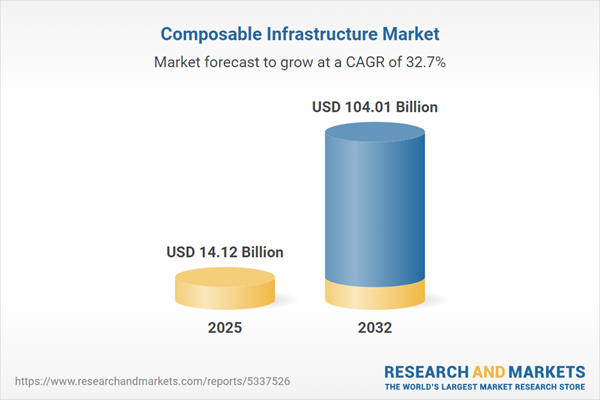Speak directly to the analyst to clarify any post sales queries you may have.
Composable infrastructure empowers enterprises to modernize IT strategy, offering a modular and agile foundation for technology management in dynamic business environments. This overview equips senior leaders to accelerate transformation with balanced insight and actionable guidance.
Market Snapshot: Composable Infrastructure Growth & Trends
The composable infrastructure market is valued at USD 10.80 billion in 2024, with projections reaching USD 14.12 billion in 2025 and a compound annual growth rate of 32.71%. Market momentum is driven by organizations shifting away from static IT models to embrace software-driven architectures that enable rapid scaling and digital execution. Enterprises across sectors utilize composable infrastructure to optimize resource allocation, increase IT flexibility, and pursue modernization strategies. Modular approaches are proving essential as businesses respond to ongoing transformation and seek a future-ready technology approach.
Scope & Segmentation: Key Areas Shaping the Composable Infrastructure Market
Comprehensive Market Segmentation
- Component: Advanced servers, high-capacity storage, networking systems, modular enclosures, consulting services, integration solutions, orchestration APIs, and suite management tools integrate to meet diverse deployment and operational needs.
- Technology: API-centric architectures, AI and machine learning integrations, Kubernetes-driven platforms, and edge computing are leveraged to support dynamic scalability and adaptability for complex workloads.
- Organization Size: Both mid-sized organizations and large enterprises benefit, gaining greater flexibility and resource efficiency as infrastructure adapts to variable demands.
- Use Cases: Implementation extends from data analytics and DevOps automation to business process modernization, disaster recovery, virtual desktop infrastructure, cloud migration, and high-performance computing.
- Industry Verticals: Sectors including banking, government, defense, healthcare, research, education, information technology, telecommunications, manufacturing, media, and retail utilize these solutions to elevate compliance, enhance security, and streamline service delivery.
- Geographic Regions: The Americas, EMEA, and Asia-Pacific regions exhibit distinct adoption trends. China, India, and Japan show particularly strong adoption, influenced by local regulatory landscapes and maturing technology ecosystems.
- Key Companies Analyzed: Cisco, Dell Technologies, HPE, IBM, Lenovo, NetApp, Microsoft, NVIDIA, Nutanix, Western Digital, Wipro, Liqid, Comport, and open infrastructure contributors are advancing innovation and shaping the competitive landscape.
Composable Infrastructure: Key Takeaways for Decision-Makers
- Aligns IT capabilities with emerging business priorities, fostering responsive and resilient enterprise operations.
- Modular design reduces integration complexity, facilitating smooth adoption of analytics, cloud services, and digital applications.
- Automation and orchestration platforms equipped with AI improve transparency, bolster compliance efforts, and reduce operational risks—vital for resilience and governance.
- Highly regulated sectors such as finance and healthcare leverage composable frameworks to strengthen data protections and maintain critical operations.
- Adoption rates vary globally, shaped by local policy dynamics and supply chain environments; readiness to transition accelerates value realization in proactive regions.
- Collaboration between established vendors and emerging providers drives interoperable, vendor-neutral solutions, minimizing dependency and enhancing organizational flexibility.
Tariff Impact: Navigating New U.S. Tariffs
Upcoming U.S. tariffs in 2025 are affecting component pricing for composable infrastructure. Senior technology leaders respond by diversifying suppliers and deploying hybrid procurement models. These approaches help safeguard budgets and sustain investment momentum, supporting uninterrupted infrastructure modernization amid regulatory shifts.
Methodology & Data Sources
This analysis integrates executive interviews, targeted market studies, and in-depth regulatory research. Combining primary and secondary data sources, the report delivers robust and reliable insights for technology investment and strategic procurement planning.
Why This Report Matters
- Equips IT leaders and procurement professionals to align infrastructure strategies with broader business objectives, driving scalable success.
- Helps organizations track evolving market and regulatory developments, remaining agile amid changes and ensuring smooth digital transformation.
- Supports durability and operational agility through clear, actionable technology planning rooted in verified market intelligence.
Conclusion
Composable infrastructure provides a resilient platform for IT advancement. Leveraging these market insights, senior leaders can confidently shape investment and drive organizational adaptability through ongoing transformation.
Additional Product Information:
- Purchase of this report includes 1 year online access with quarterly updates.
- This report can be updated on request. Please contact our Customer Experience team using the Ask a Question widget on our website.
Table of Contents
3. Executive Summary
4. Market Overview
7. Cumulative Impact of Artificial Intelligence 2025
Companies Mentioned
The companies profiled in this Composable Infrastructure market report include:- Cisco Systems, Inc.
- Colt Group Holdings Limited
- Comport Technology Solutions
- Dell Technologies Inc.
- Hewlett Packard Enterprise Development LP
- INSPUR Co., Ltd.
- International Business Machines Corporation
- Lenovo Group Limited
- Liqid Inc.
- Microsoft Corporation
- NetApp Inc.
- Nutanix, Inc.
- NVIDIA Corporation
- One Stop Systems, Inc.
- Quanta Computer Inc.
- Schneider Electric SE
- Seagate Technology LLC
- WaveMaker, Inc.
- Western Digital Corporation
- Wipro Limited
- XenonStack Pvt. Ltd.
- CIMware Technologies Private Limited.
- GigaIO Networks, Inc.
- Huawei Technologies Co., Ltd.
- Super Micro Computer, Inc.
- Dolphin Interconnect Solutions AS
- Silk Inc.
- Lightbits Labs Ltd.
- Mirantis, Inc.
- Terminal 3 HK Limited
- NTT DOCOMO Business Inc.
Table Information
| Report Attribute | Details |
|---|---|
| No. of Pages | 186 |
| Published | November 2025 |
| Forecast Period | 2025 - 2032 |
| Estimated Market Value ( USD | $ 14.12 Billion |
| Forecasted Market Value ( USD | $ 104.01 Billion |
| Compound Annual Growth Rate | 32.7% |
| Regions Covered | Global |
| No. of Companies Mentioned | 32 |









